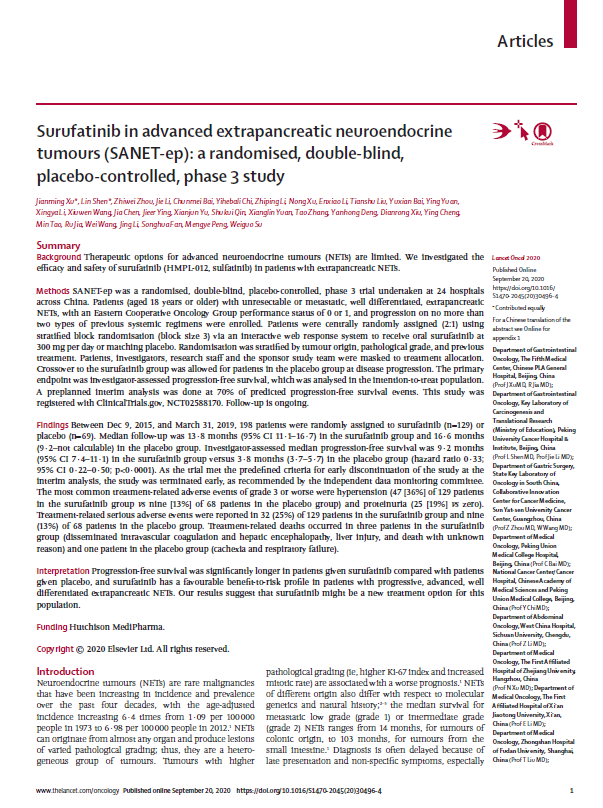- Chi-Med
- News & Presentations
- | Presentations
The Lancet Oncology: Surufatinib SANET-ep phase 3 study
Surufatinib in advanced extrapancreatic neuroendocrine tumours (SANET-ep): a randomised, double-blind, placebo-controlled, phase 3 study
Jianming Xu*, Lin Shen*, Zhiwei Zhou, Jie Li, Chunmei Bai, Yihebali Chi, Zhiping Li, Nong Xu, Enxiao Li, Tianshu Liu, Yuxian Bai, Ying Yuan, Xingya Li, Xiuwen Wang, Jia Chen, Jieer Ying, Xianjun Yu, Shukui Qin, Xianglin Yuan, Tao Zhang, Yanhong Deng, Dianrong Xiu, Ying Cheng, Min Tao, Ru Jia, Wei Wang, Jing Li, Songhua Fan, Mengye Peng, Weiguo Su
Summary
Background
Therapeutic options for advanced neuroendocrine tumours (NETs) are limited. We investigated the efficacy and safety of surufatinib (HMPL-012, sulfatinib) in patients with extrapancreatic NETs.
Methods
SANET-ep was a randomised, double-blind, placebo-controlled, phase 3 trial undertaken at 24 hospitals across China. Patients (aged 18 years or older) with unresectable or metastatic, well differentiated, extrapancreatic NETs, with an Eastern Cooperative Oncology Group performance status of 0 or 1, and progression on no more than two types of previous systemic regimens were enrolled. Patients were centrally randomly assigned (2:1) using stratified block randomisation (block size 3) via an interactive web response system to receive oral surufatinib at 300 mg per day or matching placebo. Randomisation was stratified by tumour origin, pathological grade, and previous treatment. Patients, investigators, research staff and the sponsor study team were masked to treatment allocation. Crossover to the surufatinib group was allowed for patients in the placebo group at disease progression. The primary endpoint was investigator-assessed progression-free survival, which was analysed in the intention-to-treat population. A preplanned interim analysis was done at 70% of predicted progression-free survival events. This study was registered with ClinicalTrials.gov, NCT02588170. Follow-up is ongoing.
Findings
Between Dec 9, 2015, and March 31, 2019, 198 patients were randomly assigned to surufatinib (n=129) or placebo (n=69). Median follow-up was 13·8 months (95% CI 11·1–16·7) in the surufatinib group and 16·6 months (9·2–not calculable) in the placebo group. Investigator-assessed median progression-free survival was 9·2 months (95% CI 7·4–11·1) in the surufatinib group versus 3·8 months (3·7–5·7) in the placebo group (hazard ratio 0·33; 95% CI 0·22–0·50; p<0·0001). As the trial met the predefined criteria for early discontinuation of the study at the interim analysis, the study was terminated early, as recommended by the independent data monitoring committee. The most common treatment-related adverse events of grade 3 or worse were hypertension (47 [36%] of 129 patients in the surufatinib group vs nine [13%] of 68 patients in the placebo group) and proteinuria (25 [19%] vs zero). Treatment-related serious adverse events were reported in 32 (25%) of 129 patients in the surufatinib group and nine (13%) of 68 patients in the placebo group. Treatment-related deaths occurred in three patients in the surufatinib group (disseminated intravascular coagulation and hepatic encephalopathy, liver injury, and death with unknown reason) and one patient in the placebo group (cachexia and respiratory failure).
Interpretation
Progression-free survival was significantly longer in patients given surufatinib compared with patients given placebo, and surufatinib has a favourable benefit-to-risk profile in patients with progressive, advanced, well differentiated extrapancreatic NETs. Our results suggest that surufatinib might be a new treatment option for this population.
Funding: Hutchison MediPharma.
Trial Registration: ClinicalTrials.gov Identifier: NCT02588170.
Citations and Links
Please follow the link below to access the publication:
Lancet Oncol. 2020;S1470-2045(20)30496-4. [published online ahead of print, 2020 Sep 20]
